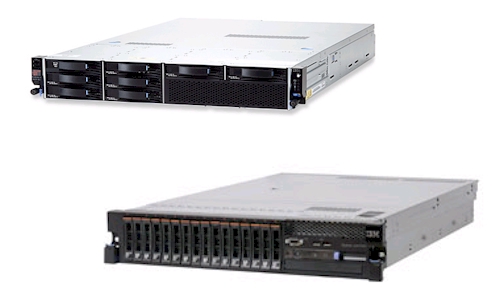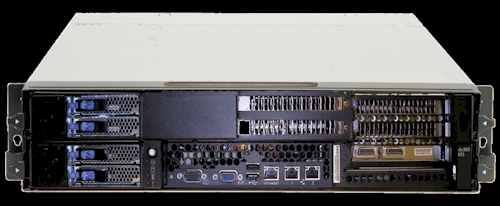Original URL: https://www.theregister.com/2010/05/18/ibm_system_x_gpu/
IBM freshens up System x servers
More Xeons and now Nvidia GPUs
Posted in Channel, 18th May 2010 20:08 GMT
IBM continued to tweak its System x lineup Tuesday when it announced more machines supporting the latest Intel Xeons, and allowed Nvidia Tesla GPU coprocessors into the systems.
Big Blue also bent some metal in its iDataPlex rackish blade servers - or bladish rack servers, depending on how you want to look at .
The moves make sense. With its System x x64-based server lineup being the only one showing growth among its three portfolios at the moment, IBM cannot afford to let Hewlett-Packard or Dell get the jump on it with a massive upgrade cycle expected for x64 machines this year.
First up in IBM's push is the System x3620 M3, what Big Blue calls a "cost-optimized" rack server, sporting two of Intel's "Westmere-EP" Xeon 5600 processors, which come in flavors with four and six cores. Part of that cost-optimization is the x3620 M3's 675 watt power supplies with 92 per cent efficiency, which will save data centers some dough over the long haul in power and cooling.
The system has a dozen DDR3 memory slots, with 1GB, 2GB, 4GB, and 8GB memory sticks supported, for a maximum capacity of 96GB. The System x3620 M3's motherboard has an internal 2GB USB flash drive for supporting embedded server virtualization hypervisors, but at this point, only VMware's ESXi 4.0 hypervisor is certified using this internal drive - although there is an embedded version of the XenServer hypervisor from Citrix, and it probably won't be too long before there is an embedded version of KVM from Red Hat, too.
The x3620 M3 comes in a 2U rack-mounted chassis that has eight 3.5-inch disk bays in the front, which can have SAS or SATA drives slid in. The system has two Gigabit Ethernet ports, two PCI Express 2.0 slots (one full-height x8 and one low-profile x4), and an integrated service processor that supports IPMI 2.0 systems management protocols.
In a base configuration, the System x3620 comes with 2GB of memory and a single four-core Xeon E5506 processor spinning at 2.13GHz; it costs $1,849. A fatter configuration with a six-core 2.66GHz Xeon X5650 and 12GB of memory runs $4,609. But beefing this puppy up costs some cash: adding a second processor, putting in four 600GB 15K RPM SAS disks, and pumping up memory to 36GB pushes the price up to $13,120 - and that's without an operating system or hardware tech support.
The System x3620 M3 is certified to run Microsoft Windows Server 2003 R2, Windows Server 2008, and Windows Server 2008 R2; Novell SUSE Linux Enterprise Server 10 SP3 and 11 (including the integrated Xen hypervisor); Red Hat Enterprise Linux 5.4; and VMware ESX Server 4.0 and ESXi 4.0 Update 1. The server will start shipping on June 8.

The IBM System x3620 M3 (top left) and x3650 M3 (bottom right) rack servers.
The System x3650 M3, which was announced as part of the Xeon 5600 server rollout in March, has been tweaked this week, too. The x3650 M3 is a 2U rack server with two processor sockets certified to run Intel's Xeon 5600 processors in either the four-core or six-core variants, as we said it would be back in March. This being the week of SAP's annual Sapphire user group meeting, IBM is rolling out a variant of the x3650 M3 that is preloaded with SAP's Discovery System V4 software, which is a tool that SAP uses to allow customers to test-drive its ERP and BI software suites. The System 3650 M3 doesn't seem to have been changed in any other significant way, and will be available on June 10.
The x3650 M3 has 18 memory slots and supports up to 144GB of main memory across its two Xeon 5600 sockets. It has room for 16 2.5-inch drives (SAS or SATA), and four PCI Express 2.0 x8 slots. The machine features the same 675 watt, 92 per cent efficiency power supplies used in the x3620 M3, and sports two Gigabit Ethernet ports.
In a base configuration with a four-core 2.26GHz Xeon E5507 processor and 6GB of main memory, the x3620 M3 costs $2,285. Moving up to a six-core X5680 running at 3.33GHz and boosting memory to 12GB raises the price of the base machine to $5,569. Doubling up the CPUs on this machine, adding four 146GB, 15K RPM SAS drives, and pushing memory to 36GB cranks the price up to $15,519.
New hotness: GPU coprocessors
IBM has also rejiggered its iDataPlex dx360 M3, which was originally launched in an M2 product supporting Intel's four-core "Nehalem-EP" Xeon 5500 processors a year ago. With the dx360 M3, the machine is a 2U compute node, just like the M2 model from last year, with two stacked trays for supporting compute resources. Each tray in the dx360 M3 can be configured with a two-socket Xeon 5600 server with 16 memory slots, or up to 128GB using 8GB memory sticks. Each tray also has room for two 2.5-inch disks and two PCI Express 2.0 slots for linking in InfiniBand or Ethernet connectivity above and beyond the two Gigabit Ethernet ports on the system board and the 100Mbit Ethernet port for the on-board service processor.

The IM iDataPlex dx360 M3, seen here with Nvidia Tesla M20s on top.
But with the M3 variant of the dx360, the upper tray can now be equipped with two of Nvidia's Tesla graphics coprocessors. IBM is supporting the old Tesla M1060 or the new Fermi-based M2050 GPU coprocessors in this iDataPlex node. This is the first time one of the big tier-one server makers has endorsed the Nvidia GPU coprocessors inside their machines, although whitebox server and motherboard maker Super Micro and niche supercomputer player Appro International were first out the door two weeks ago supporting the embedded M2050 Fermi co-processors.
HP and Dell, which have considerable stakes in the HPC racket, have not put the embedded M series co-processors into their rack or blade servers, but as the CPU-GPU hybrid computing model takes off, you can bet they will. Perhaps next week, in fact, at the International Super Computing conference in Hamburg, Germany, or at SC10 in New Orleans in November.
The M2050 GPU co-processor is rated at 515 gigaflops of double-precision and 1.03 teraflops single-precision floating point performance and is a fanless card that plugs into the PCI Express bus to allow mathematical calculations to be offloaded from the CPUs, which have a lot less computing oomph these days.
The iDataPlex rack is not a normal 42U server rack, but rather a half-depth, double-wide rack with two vertical stacks of iDataPlex server chassis, which have different tray options inside the chassis. The iDataPlex rack has 84U of server space, and that means it can hold 42 of the 2U dx360 M3 compute nodes that accept Nvidia Tesla co-processors, for a total of 86.5 teraflops of GPU oomph per rack (at single precision).
IBM only sells the iDataPlex gear on a special-bid basis, so no word on what the hybrid CPU-GPU nodes might cost.
Tuesday also saw IBM expand its new System x3850 X5 servers, sporting Intel's "Nehalem-EX" Xeon 7500 processors. When the x3850 X5 came out at the end of March, it was just a four-socket server sporting IBM's eX5 chipset. The x3850 X5 did not support the new Max5 memory expansion chassis, a 1U box with 32 DDR3 memory slots that use the eX5 chipset to link them to the 64 memory slots in the server proper.
Think of the Max5 as a server node in a NUMA cluster that just so happens to not have any processors in it and you will see how it works.
IBM said that the x3850 would eventually scale to an eight-socket box and would also support the Max5 memory extensions, and that happened Tuesday. In fact, each node in the two-node, eight-socket configuration of the x3850 X5 server can have a Max5 memory expansion unit, for a total of 192 memory slots across 64 processor cores using the top-bin eight-core Xeon 7500s. That's 1.5TB of main memory using 8GB memory sticks.
IBM supports 16GB sticks in this x3850 X5 machine, at $1,549 a pop, which is nearly the same price per gigabyte it charges for 8GB sticks - so if you are thinking about going dense on the memory, you might was well go all the way from the beginning. (8GB and 16GB sticks costs about a third more per gigabyte than 4GB sticks at IBM list price.)
The Max5 memory expansion module costs $7,495, so for certain workloads and configurations, using 16GB sticks in the main chassis makes more sense than adding the Max5 unit and trying to save money using 4GB sticks to build up capacity - do a little back-of-the-envelope capacity planning and then the math before you buy.
A base x3850 X5 with two four-core, 1.86GHz Xeon E7520 processors, 4GB of memory, and no disks costs $9,049. An x3850 X5 server with four of the eight-core, 2.26GHz Xeon X7560 processors, 96GB of memory, and no disks runs to $45,246.
One last thing: IBM says that the Max5 memory extension feature is designed to be seamless as far as operating systems go, but that VMware's ESX Server 4.0 hypervisor cannot see the memory extender - somebody wrote their code a little too tightly to the iron. A future release of ESX Server will support the Max5 feature, however. ®